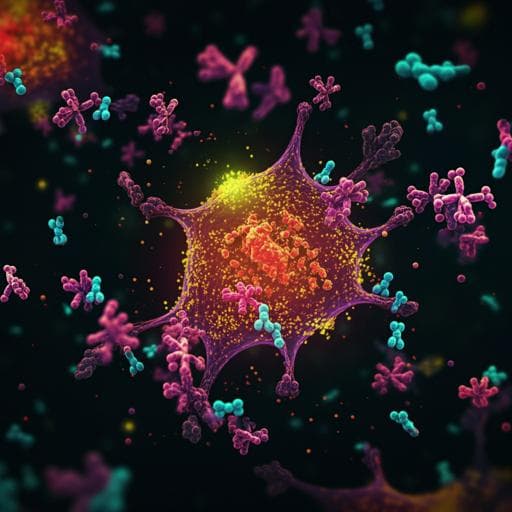
Medicine and Health
Neoadjuvant nivolumab or nivolumab plus LAG-3 inhibitor relatlimab in resectable esophageal/gastroesophageal junction cancer: a phase Ib trial and ctDNA analyses
R. J. Kelly, B. V. Landon, et al.
This phase Ib trial explores the safety and effectiveness of neoadjuvant nivolumab and nivolumab-relatlimab combined with chemoradiotherapy in patients with resectable stage II/III gastroesophageal cancer. Results indicate promising rates of pathological response and improved recurrence-free and overall survival, with greater responses linked to baseline PD-L1 and LAG-3 expression. Conducted by a collaborative team of experts, this study sheds light on immunotherapeutic strategies in cancer treatment.
~3 min • Beginner • English
Introduction
There have been limited advances for resectable esophageal/gastroesophageal junction (E/GEJ) cancers, with many patients progressing within 5 years. Adjuvant nivolumab after neoadjuvant chemoradiotherapy (CRT) and surgery improved outcomes (CheckMate 577), suggesting a role for immune checkpoint inhibitors (ICI). Early-stage E/GEJ tumors can have high PD-L1 expression and neoadjuvant CRT may prime PD-L1, providing a rationale for combining CRT with ICIs. LAG-3 is highly expressed in gastroesophageal cancers and co-inhibition of PD-1 and LAG-3 may reinvigorate exhausted T cells and enhance antitumor immunity. Prior neoadjuvant PD-1 pathway inhibitor combinations with CRT in operable E/GEJ cancer have shown conflicting results. Circulating tumor DNA (ctDNA) can dynamically assess systemic tumor burden during neoadjuvant ICI and may help identify patients likely to achieve pathological responses preoperatively and detect minimal residual disease (MRD) postoperatively, but its predictive versus prognostic role remains unclear in this setting. This study evaluates the safety, feasibility, efficacy, and biomarker correlates (including PD-L1, LAG-3, ctDNA, and neoantigen-specific T cell responses) of neoadjuvant nivolumab or nivolumab plus relatlimab combined with CRT in resectable stage II/III E/GEJ cancer.
Literature Review
The study builds on: (1) CheckMate 577 demonstrating the benefit of adjuvant nivolumab in resected E/GEJ cancers after neoadjuvant CRT; (2) evidence that PD-L1 is often upregulated in E/GEJ tumors and can be induced by CRT, providing rationale for PD-1 blockade; (3) recognition of LAG-3 as a co-inhibitory receptor expressed in gastroesophageal cancers with clinical benefit of LAG-3/PD-1 combination in melanoma (RELATIVITY-047); and (4) mixed results from prior trials combining neoadjuvant ICIs with CRT in E/GEJ (for example, pembrolizumab, atezolizumab, camrelizumab). Additionally, expanding literature supports ctDNA as a dynamic biomarker of tumor burden and MRD across tumor types, but data in neoadjuvant immuno-CRT for E/GEJ cancers had been lacking. The authors position their trial to address these gaps by integrating comprehensive biomarker analyses with clinical endpoints.
Methodology
Design: Phase Ib, open-label, multi-institution trial (NCT03044613) at Johns Hopkins, Allegheny Health Network, and Baylor. Adults with resectable clinical stage II/III distal E/GEJ adenocarcinoma or squamous cell carcinoma (AJCC 7th), ECOG 0–1, adequate organ function and cardiopulmonary status were eligible. Key exclusions included mid/proximal esophageal tumors, autoimmune disease, prior ICI, significant cardiopulmonary disease, and (Arm B only) cardiac risk factors or myocarditis.
Treatment arms (consecutive enrollment):
- Arm A: Nivolumab 240 mg every 2 weeks for two induction cycles, then three additional doses concurrent with CRT (total five doses).
- Arm B: Initially nivolumab 240 mg + relatlimab 80 mg every 2 weeks for two induction cycles plus three concurrent with CRT (same schedule as Arm A). Due to unacceptable toxicity in the first nine patients, a December 2019 amendment removed concurrent dual ICI during CRT; the subsequent seven patients in Arm B received only the two induction cycles of nivolumab + relatlimab before CRT.
CRT regimen: Weekly carboplatin (AUC 2) + paclitaxel (50 mg/m²) with radiotherapy 50.4 Gy in 28 fractions (IMRT/VMAT allowed). Planned Ivor Lewis esophagectomy 6–8 weeks after CRT (no more than 11 weeks). Adjuvant therapy allowed per standard of care.
Endpoints: Primary—safety (TRAEs within 100 days after last nivolumab dose or within 30 days post-surgery). Secondary—feasibility (proportion proceeding to surgery without substantial delay >11 weeks after CRT). Exploratory—pCR, MPR (≤10% residual viable tumor), RFS, OS, and biomarker analyses (PD-L1 CPS, HER2, MMR, LAG-3 expression; serial ctDNA; neoantigen-specific T cell responses).
Assessments and biospecimens: Baseline CT and PET/CT; presurgery PET/CT. Tumor biopsies at baseline, after two induction ICI cycles, and at surgery. Blood at baseline, start of cycles 2 and 3, pre-op, and 3–12 weeks post-op.
Pathology/IHC: Modified Ryan scheme/CAP grading (G0–G3) with percent residual viable tumor. IHC for PD-L1 (22C3 CPS), HER2 (4B5, 0–3+ per CAP/TOGA), and DNA MMR proteins (MLH1, PMS2, MSH2, MSH6). NanoString IO360 panel for gene expression including LAG-3 (normalized log2 expression).
ctDNA: Targeted error-correction sequencing (TEC-seq) high-coverage NGS on 173 serial plasma samples with matched WBC DNA from 32 patients. Tumor-agnostic, WBC-informed approach to classify variant origin (germline, clonal hematopoiesis, tumor-derived) using VariantDx, OpenCRAVAT/COSMIC hotspot annotation, super mutant count thresholds, and IGV review. ctDNA status defined as detectable (ctDNA+) if ≥1 tumor-derived variant detected at any MAF; undetectable (ctDNA−) otherwise. Timepoints: baseline, day 14, post-ICI (after two cycles), pre-op, post-op (3–12 weeks). Patients without tumor-derived variants at any timepoint were categorized as ctDNA undetectable throughout (ctDNA UD) and considered nonevaluable for dynamic analyses.
Neoantigen-specific T cell assays: MANAFEST assay on peripheral blood CD8+ T cells with ex vivo peptide stimulation (40–60 predicted neoantigens per patient in pools) and TCRβ sequencing to identify significant neoantigen-specific clonotypic expansions.
Statistics: Safety monitored with Bayesian continuous toxicity rules (stop if posterior probability of grade 3–4 pneumonitis/acute respiratory failure >30% ≥70%; or grade 5 AE >10%). Exact binomial 95% CIs for proportions. Kaplan–Meier for RFS/OS with log-rank tests. Fisher’s exact and Wilcoxon rank-sum for categorical and nonparametric comparisons. Analyses in R. Sample size: 16 evaluable per arm.
Key Findings
- Enrollment and treatment: 42 screened; 32 enrolled (16 per arm). 28 completed neoadjuvant therapy; 4 discontinued ICI due to irAEs (1 Arm A, 3 Arm B). 29 underwent esophagectomy (median 8 weeks post-CRT).
Safety/feasibility:
- Primary safety endpoint met for Arm A (nivo+CRT). Dual ICI (nivo/relatlimab+CRT) had unacceptable toxicity in first 9/16 patients; protocol amended to induction-only dual ICI before CRT.
- Any-grade TRAEs in all patients. Grade ≥3 TRAEs: 31.3% overall (95% CI 16.1–50.0%); 18.8% (Arm A) vs 43.8% (Arm B).
- irAEs in 53.1% overall (Arm A 31.3%; Arm B 75.0%); most common: dermatitis (31.3%), elevated AST/ALT (12.5%), hypothyroidism (12.5%). Grade ≥3 irAEs in 25.0% overall (Arm A 12.5%; Arm B 37.5%); notably dermatitis (12.5%), pericarditis (6.3%; both Arm B), adrenal insufficiency (6.3%; both Arm B). One grade 2 pneumonitis (radiation-related), no grade ≥3 treatment-related pneumonitis/acute respiratory failure. One postoperative death from septic shock (not related to systemic therapy).
- Feasibility: Among eligible patients, all proceeded to planned surgery without substantial treatment-related delay (>11 weeks), except one at 11.4 weeks due to travel logistics; 100% feasibility by predefined criterion.
Pathologic response and efficacy:
- pCR among resected: Arm A 40.0% (95% CI 16.3–67.7%); Arm B 21.4% (95% CI 4.7–50.8%).
- MPR (≤10% residual viable tumor): Arm A 53.5% (95% CI 26.6–78.7%); Arm B 57.1% (95% CI 28.9–82.3%).
- By histology: pCR/MPR—adenocarcinoma 30.8%/50.0%; SCC 33.3%/100.0%.
- R0 resection rate 100%. Median follow-up 36.4 months overall (Arm A 43.9, Arm B 27.5).
- Median RFS 41.1 months overall (Arm A 34.1; Arm B not reached). Two-year RFS 72.5% overall (Arm A 62.5%; Arm B 87.1%). Two-year OS 82.6% overall (Arm A 75.0%; Arm B 93.8%); median OS not reached in either arm.
Biomarkers (PD-L1, LAG-3):
- Baseline PD-L1 CPS evaluable in 29/32; 37.9% CPS <1; 62.1% CPS ≥1. No arm difference (P=0.95). In resected residual tumors, 80% PD-L1 positive.
- Baseline PD-L1 CPS ≥5 associated with longer RFS (median NR vs 29.34 months; P=0.013), trend to longer OS (P=0.13). No significant association with pCR/MPR (trend for enrichment CPS ≥5 in pCR; P=0.089).
- Baseline LAG-3 expression higher in MPR vs non-MPR (median log2 6.68 vs 6.01; P=0.016) and trended higher in pCR vs non-pCR (6.78 vs 6.08; P=0.059). Effect driven by Arm B (MPR vs non-MPR median 6.77 vs 5.95; P=0.016). No correlation in Arm A.
ctDNA dynamics and outcomes:
- Across 141 evaluable plasma samples, 74 alterations identified: 12 germline, 27 CH, 35 tumor-derived. Tumor-derived variants in 62.5% (20/32) of patients; 37.5% had only CH/germline variants (ctDNA UD group for dynamics).
- ctDNA detection at post-ICI associated with >20% residual tumor at resection (Fisher’s exact P=0.034); baseline ctDNA levels did not correlate with residual tumor.
- RFS associations: Undetectable ctDNA post-ICI associated with longer RFS vs detectable (median NR vs 21.54 months; P=0.032). Undetectable pre-op ctDNA associated with longer RFS vs detectable (32.72 vs 7.80 months; P=0.012). Undetectable post-op ctDNA associated with longer RFS vs detectable (median NR vs 7.80 months; P=0.007). Patients with undetectable ctDNA throughout or post-ICI had improved RFS (overall P=0.038).
- OS showed consistent trends: improved OS with undetectable ctDNA post-ICI (P=0.07), pre-op (P=0.023 overall; P=0.075 excluding ctDNA UD), and post-op (P=0.017).
- In non-pCR patients, undetectable post-ICI ctDNA trended to longer RFS vs detectable (median NR vs 21.54 months; P=0.058). Pathologic responses (pCR/MPR) were less predictive of RFS/OS than ctDNA among patients with evaluable ctDNA.
- Combined PD-L1/ctDNA: Undetectable post-ICI ctDNA predicted longer RFS independent of PD-L1 CPS (P=0.0052); worst outcomes in PD-L1 CPS <5 with positive ctDNA.
Neoantigen-specific T cells:
- MANAFEST detected circulating neoantigen-specific T cells in all tested pCR cases (n=4) and in 1/3 non-pCR cases. Neoantigen-specific TCR clone expansions mirrored ctDNA clearance and favorable long-term outcomes; absence of expansions associated with ctDNA persistence and early recurrence.
Discussion
This phase Ib study demonstrates that neoadjuvant nivolumab plus CRT is safe and feasible, while concurrent dual PD-1/LAG-3 blockade with CRT requires modification due to elevated irAEs (notably pericarditis and adrenal insufficiency). Clinically, pCR and MPR rates with nivolumab+CRT compared favorably to historical CRT controls despite a lower proportion of SCC, and survival outcomes were encouraging in both arms, with numerically higher 2-year RFS/OS in the amended relatlimab arm despite higher toxicity and lower pCR, underscoring that pCR may not be a reliable surrogate for survival in operable E/GEJ cancer.
Biomarker analyses provide mechanistic and translational insights. Baseline PD-L1 CPS ≥5 enriched for longer RFS, aligning with prior observations of PD-L1 as an enrichment marker. Higher baseline LAG-3 expression associated with deeper pathologic responses, particularly in the relatlimab arm, suggesting LAG-3 expression could be predictive of benefit from LAG-3/PD-1 co-inhibition.
Most notably, ctDNA kinetics provided a dynamic and superior predictor of outcomes compared to pathologic responses. Early ctDNA clearance after ICI induction and undetectable ctDNA pre- and post-operatively correlated with significantly improved RFS (and OS trends), including within the non-pCR subgroup where ctDNA negativity identified patients with excellent outcomes. ctDNA trajectories mirrored functional antitumor immunity, with neoantigen-specific T cell expansions accompanying ctDNA clearance. These findings support ctDNA as a real-time, systemic measure of tumor burden and residual disease that could inform perioperative treatment decisions, including potential de-escalation for early clearers or escalation for ctDNA-positive patients.
Conclusion
Neoadjuvant nivolumab plus CRT is active and feasible in resectable E/GEJ cancer, achieving higher pCR and 2-year OS rates than historical CRT, while addition of relatlimab increases irAEs and requires careful sequencing. Baseline PD-L1 CPS ≥5 and higher LAG-3 expression associate with favorable responses, particularly for dual ICI. ctDNA dynamics provide a sensitive, dynamic measure of tumor burden: early post-ICI clearance and undetectable pre-/post-op ctDNA predict longer RFS/OS and outperform pathologic response in prognostication, including among non-pCR patients. Neoantigen-specific T cell expansions mirror ctDNA clearance, linking molecular residual disease with functional immunity.
Future directions include larger, randomized studies to validate ctDNA-guided perioperative strategies, optimize the sequencing and timing of dual ICI with CRT, and evaluate more sensitive liquid biopsy platforms (including tumor-informed and genome-wide cfDNA approaches) to enhance MRD detection and guide escalation/de-escalation of therapy.
Limitations
- Small, phase Ib cohort (n=32) limits statistical power and generalizability; arm comparisons are exploratory and non-randomized.
- Dual ICI concurrent with CRT had high toxicity prompting protocol modification; optimal sequencing remains unresolved.
- A substantial subset had undetectable tumor-derived ctDNA at all time points, likely reflecting early-stage disease and limited sensitivity of the tumor-agnostic panel in low-burden settings (typical analytical sensitivity ~0.1–0.2% MAF). Tumor-informed or genome-wide cfDNA approaches may improve sensitivity.
- Reliance on historical controls for efficacy context (no randomized CRT control arm).
- Limited matched baseline/resection specimens constrained analyses of PD-L1 dynamics and some biomarker correlations.
Related Publications
Explore these studies to deepen your understanding of the subject.







